programming RENAULT SCENIC 2014 J95 / 3.G Petrol Injection - Sagem3000 User Guide
[x] Cancel search | Manufacturer: RENAULT, Model Year: 2014, Model line: SCENIC, Model: RENAULT SCENIC 2014 J95 / 3.GPages: 181
Page 42 of 181

PETROL INJECTION
Fault finding – Interpretation of faults17B
17B-42V12 MR-372-J84-17B000$315.mif
SAGEM 3000
Program No.: A7
Vdiag No.: 44, 48
DF061
CONTINUED
Combustion
misfires on all
four cylinders
(see DF060, DF061
and DF062)
The fault is probably due to a component affecting all the cylinders:
– check that the correct fuel is being used,
– check the condition and conformity of the spark plugs.
– Carry out the steps "according to the repair".
If the fault is still present, carry out the following checks:
– check the flywheel sensor,
– check the condition and cleanliness of the flywheel,
– check the flywheel sensor mounting,
– check the flywheel/sensor air gap
– check the cylinder compressions,
– check the complete fuel supply system (see Workshop Repair Manual 364 Mechanics, 13A, Fuel supply),
– check the entire ignition system (see MR 364, Mechanics, 17A, Ignition),
– check the hydraulic tappets if there is camshaft noise (seeMR 364 Mechanics, 11A, Top and front of engine).
– Carry out the steps "according to the repair".
If the fault is still present, deal with the other faults then proceed to the conformity check.
AFTER REPAIREnsure that all the faults have been dealt with.
Clear the stored faults. Do not clear the programming.
To check that the system has been properly repaired:
– there must be no further electrical faults,
– programming has been carried out,
– warm engine (minimum 75°C).
– running at idle speed with all electrical consumers drawing power for 15 minutes.
– if the fault is still absent, check that the catalytic converter is in good condition. Use
command SC006 Run OBD Test: Catalytic converter.
JSAA741.0
Page 43 of 181
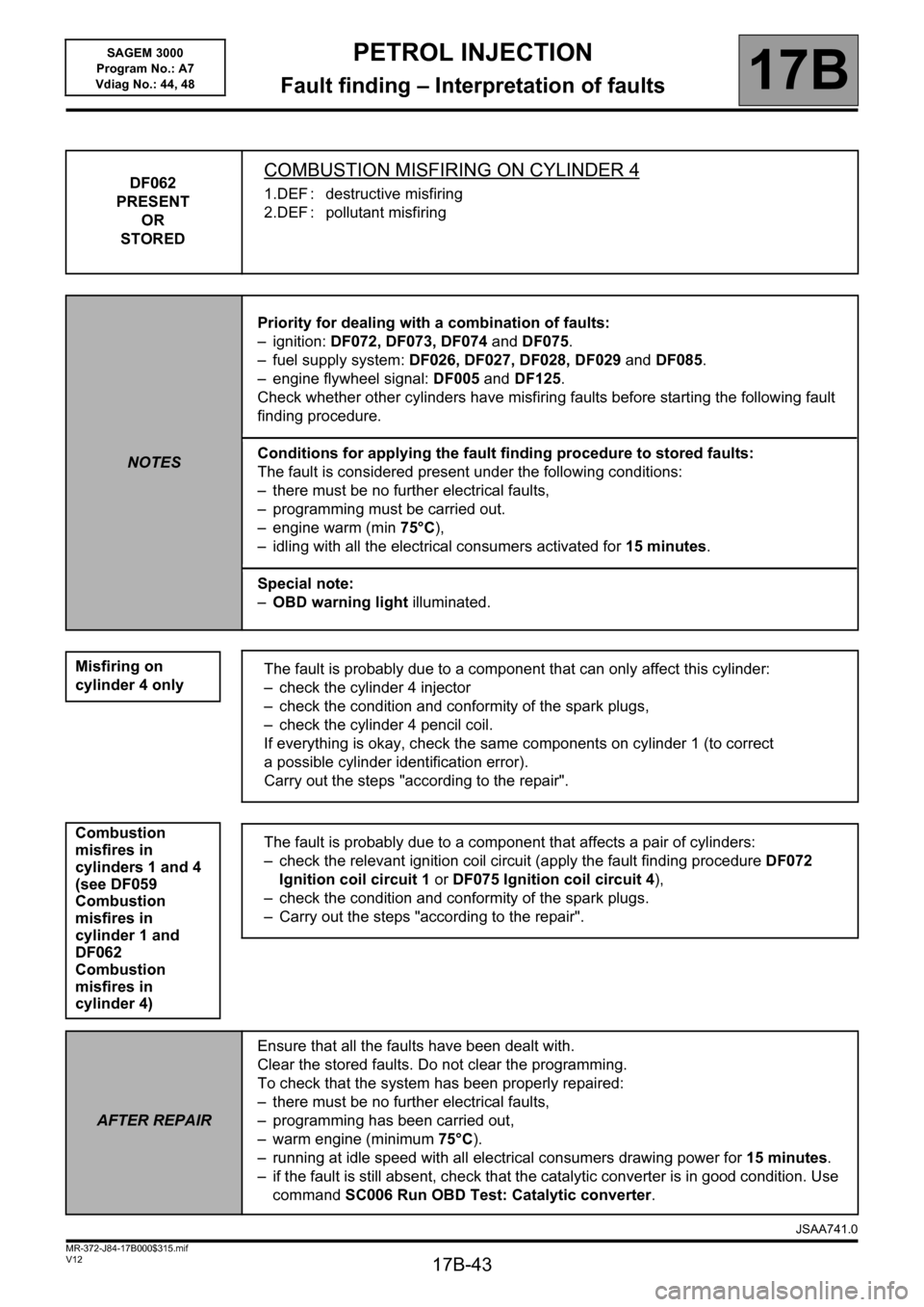
PETROL INJECTION
Fault finding – Interpretation of faults17B
17B-43V12 MR-372-J84-17B000$315.mif
SAGEM 3000
Program No.: A7
Vdiag No.: 44, 48
DF062
PRESENT
OR
STOREDCOMBUSTION MISFIRING ON CYLINDER 4
1.DEF : destructive misfiring
2.DEF : pollutant misfiring
NOTESPriority for dealing with a combination of faults:
– ignition: DF072, DF073, DF074 and DF075.
– fuel supply system: DF026, DF027, DF028, DF029 and DF085.
– engine flywheel signal: DF005 and DF125.
Check whether other cylinders have misfiring faults before starting the following fault
finding procedure.
Conditions for applying the fault finding procedure to stored faults:
The fault is considered present under the following conditions:
– there must be no further electrical faults,
– programming must be carried out.
– engine warm (min 75°C),
– idling with all the electrical consumers activated for 15 minutes.
Special note:
–OBD warning light illuminated.
Misfiring on
cylinder 4 only
Combustion
misfires in
cylinders 1 and 4
(see DF059
Combustion
misfires in
cylinder 1 and
DF062
Combustion
misfires in
cylinder 4)
The fault is probably due to a component that can only affect this cylinder:
– check the cylinder 4 injector
– check the condition and conformity of the spark plugs,
– check the cylinder 4 pencil coil.
If everything is okay, check the same components on cylinder 1 (to correct
a possible cylinder identification error).
Carry out the steps "according to the repair".
The fault is probably due to a component that affects a pair of cylinders:
– check the relevant ignition coil circuit (apply the fault finding procedure DF072
Ignition coil circuit 1 or DF075 Ignition coil circuit 4),
– check the condition and conformity of the spark plugs.
– Carry out the steps "according to the repair".
AFTER REPAIREnsure that all the faults have been dealt with.
Clear the stored faults. Do not clear the programming.
To check that the system has been properly repaired:
– there must be no further electrical faults,
– programming has been carried out,
– warm engine (minimum 75°C).
– running at idle speed with all electrical consumers drawing power for 15 minutes.
– if the fault is still absent, check that the catalytic converter is in good condition. Use
command SC006 Run OBD Test: Catalytic converter.
JSAA741.0
Page 44 of 181

PETROL INJECTION
Fault finding – Interpretation of faults17B
17B-44V12 MR-372-J84-17B000$315.mif
SAGEM 3000
Program No.: A7
Vdiag No.: 44, 48
DF062
CONTINUED
Combustion
misfires on all
four cylinders
(see DF060, DF061
and DF062)
The fault is probably due to a component affecting all the cylinders:
– check that the correct fuel is being used,
– check the condition and conformity of the spark plugs.
– Carry out the steps "according to the repair".
If the fault is still present, carry out the following checks:
– check the flywheel sensor,
– check the condition and cleanliness of the flywheel,
– check the flywheel sensor mounting,
– check the flywheel/sensor air gap
– check the cylinder compressions,
– check the complete fuel supply system (see Workshop Repair Manual 364 Mechanics, 13A, Fuel supply),
– check the entire ignition system (see MR 364, Mechanics, 17A, Ignition),
– check the hydraulic tappets if there is camshaft noise (seeMR 364 Mechanics, 11A, Top and front of engine).
– Carry out the steps "according to the repair".
If the fault is still present, deal with the other faults then proceed to the conformity check.
AFTER REPAIREnsure that all the faults have been dealt with.
Clear the stored faults. Do not clear the programming.
To check that the system has been properly repaired:
– there must be no further electrical faults,
– programming has been carried out,
– warm engine (minimum 75°C).
– running at idle speed with all electrical consumers drawing power for 15 minutes.
– if the fault is still absent, check that the catalytic converter is in good condition. Use
command SC006 Run OBD Test: Catalytic converter.
JSAA741.0
Page 45 of 181

PETROL INJECTION
Fault finding – Interpretation of faults17B
17B-45V12 MR-372-J84-17B000$315.mif
SAGEM 3000
Program No.: A7
Vdiag No.: 44, 48
DF065
PRESENT
OR
STOREDCOMBUSTION MISFIRES
1.DEF : destructive misfiring
2.DEF : pollutant misfiring
NOTESPriority for dealing with a combination of faults:
– ignition: DF072, DF073, DF074 and DF075.
– fuel supply system: DF026, DF027, DF028, DF029 and DF085.
– engine flywheel signal: DF005 and DF125.
– cylinder misfires: DF059, DF060, DF061 and DF062.
Conditions for applying the fault finding procedure to stored faults:
The fault is considered present under the following conditions:
– there must be no further electrical faults,
– programming must be carried out.
– engine warm (min 75°C),
– idling with all the electrical consumers activated for 15 minutes.
Special note:
–OBD warning light illuminated.
Check the injectors.
Check the condition and conformity of the spark plugs.
Check the ignition pencil coils.
Check that the correct fuel is being used.
If the fault is still present, carry out the following checks:
– check the flywheel sensor,
– check the condition and cleanliness of the flywheel,
– check the flywheel sensor mounting,
– check the flywheel/sensor air gap
– check the cylinder compressions,
– check the complete fuel supply system (see Workshop Repair Manual 364 Mechanics, 13A, Fuel supply),
– check the entire ignition system (see MR 364, Mechanics, 17A, Ignition),
– check the hydraulic tappets if there is camshaft noise (seeMR 364 Mechanics, 11A, Top and front of engine).
– Carry out the steps "according to the repair".
If the fault is still present, deal with the other faults then proceed to the conformity check.
AFTER REPAIREnsure that all the faults have been dealt with.
Clear the stored faults. Do not clear the programming.
To check that the system has been properly repaired:
- there must be no further electrical faults,
- programming has been carried out,
- the engine should be warm (minimum temperature 75°C),
- running at idle speed with all the electrical consumers activated for 15 minutes,
- if the fault is still absent, check that the catalytic converter is in working order. Use
command SC006 Run OBD Test: Catalytic converter.
JSAA741.0
Page 51 of 181
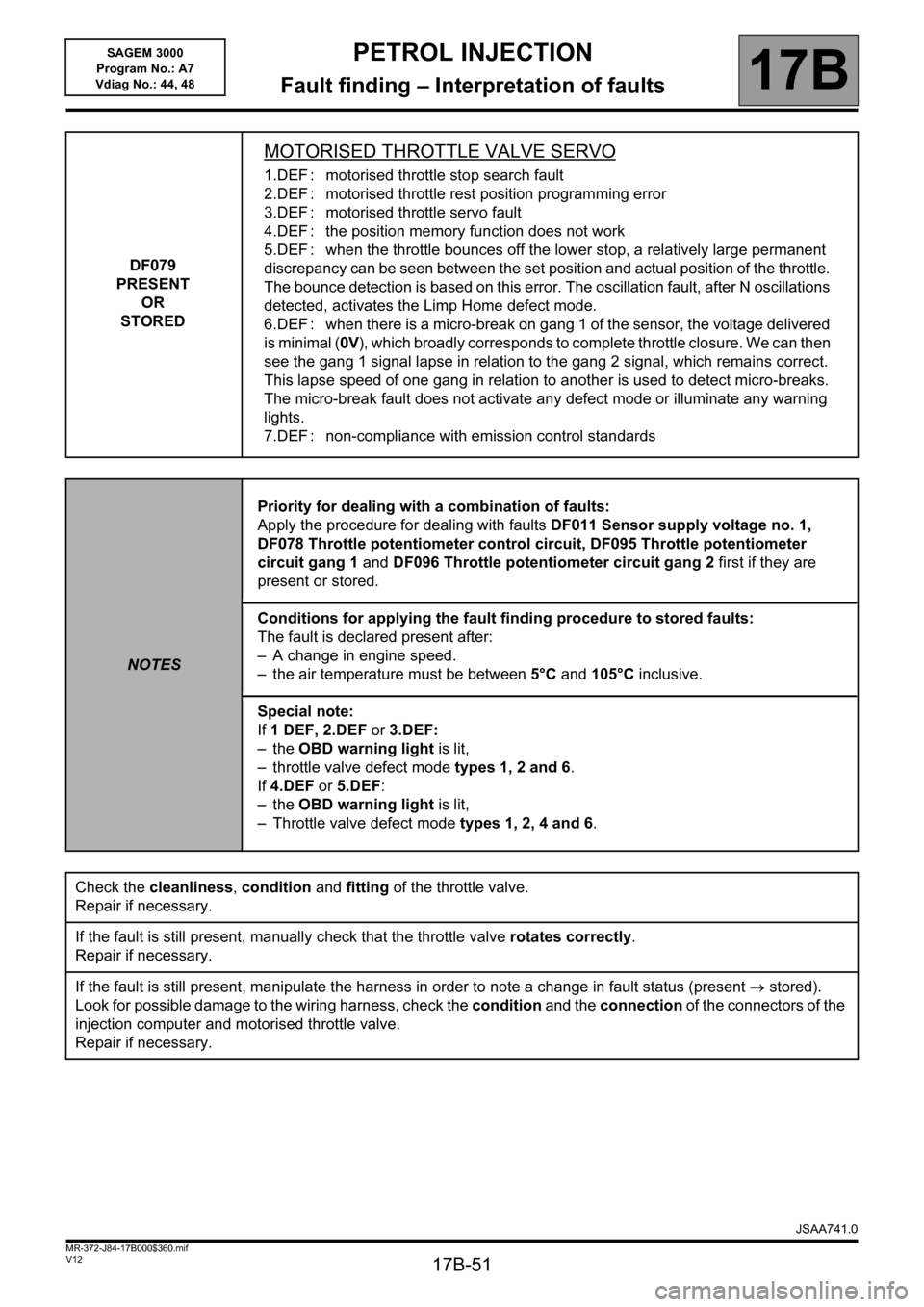
PETROL INJECTION
Fault finding – Interpretation of faults17B
17B-51V12 MR-372-J84-17B000$360.mif
SAGEM 3000
Program No.: A7
Vdiag No.: 44, 48
DF079
PRESENT
OR
STORED
MOTORISED THROTTLE VALVE SERVO
1.DEF : motorised throttle stop search fault
2.DEF : motorised throttle rest position programming error
3.DEF : motorised throttle servo fault
4.DEF : the position memory function does not work
5.DEF : when the throttle bounces off the lower stop, a relatively large permanent
discrepancy can be seen between the set position and actual position of the throttle.
The bounce detection is based on this error. The oscillation fault, after N oscillations
detected, activates the Limp Home defect mode.
6.DEF : when there is a micro-break on gang 1 of the sensor, the voltage delivered
is minimal (0V), which broadly corresponds to complete throttle closure. We can then
see the gang 1 signal lapse in relation to the gang 2 signal, which remains correct.
This lapse speed of one gang in relation to another is used to detect micro-breaks.
The micro-break fault does not activate any defect mode or illuminate any warning
lights.
7.DEF : non-compliance with emission control standards
NOTESPriority for dealing with a combination of faults:
Apply the procedure for dealing with faults DF011 Sensor supply voltage no. 1,
DF078 Throttle potentiometer control circuit, DF095 Throttle potentiometer
circuit gang 1 and DF096 Throttle potentiometer circuit gang 2 first if they are
present or stored.
Conditions for applying the fault finding procedure to stored faults:
The fault is declared present after:
– A change in engine speed.
– the air temperature must be between 5°C and 105°C inclusive.
Special note:
If 1 DEF, 2.DEF or 3.DEF:
– the OBD warning light is lit,
– throttle valve defect mode types 1, 2 and 6.
If 4.DEF or 5.DEF:
– the OBD warning light is lit,
– Throttle valve defect mode types 1, 2, 4 and 6.
Check the cleanliness, condition and fitting of the throttle valve.
Repair if necessary.
If the fault is still present, manually check that the throttle valve rotates correctly.
Repair if necessary.
If the fault is still present, manipulate the harness in order to note a change in fault status (present stored).
Look for possible damage to the wiring harness, check the condition and the connection of the connectors of the
injection computer and motorised throttle valve.
Repair if necessary.
JSAA741.0
Page 52 of 181
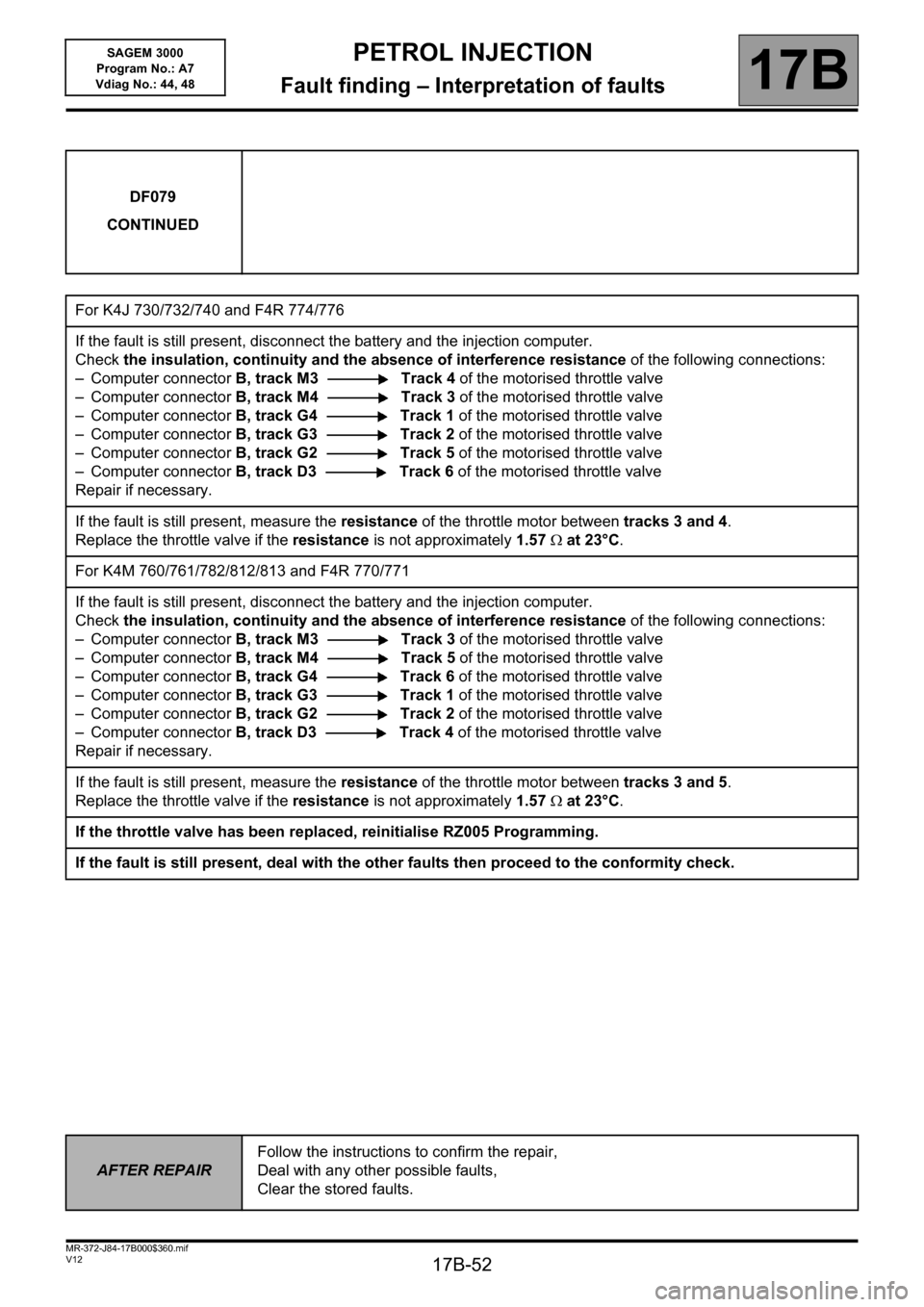
PETROL INJECTION
Fault finding – Interpretation of faults17B
17B-52V12 MR-372-J84-17B000$360.mif
SAGEM 3000
Program No.: A7
Vdiag No.: 44, 48
DF079
CONTINUED
For K4J 730/732/740 and F4R 774/776
If the fault is still present, disconnect the battery and the injection computer.
Check the insulation, continuity and the absence of interference resistance of the following connections:
– Computer connector B, track M3 Track 4 of the motorised throttle valve
– Computer connector B, track M4 Track 3 of the motorised throttle valve
– Computer connector B, track G4 Track 1 of the motorised throttle valve
– Computer connector B, track G3 Track 2 of the motorised throttle valve
– Computer connector B, track G2 Track 5 of the motorised throttle valve
– Computer connector B, track D3 Track 6 of the motorised throttle valve
Repair if necessary.
If the fault is still present, measure the resistance of the throttle motor between tracks 3 and 4.
Replace the throttle valve if the resistance is not approximately 1.57 at 23°C.
For K4M 760/761/782/812/813 and F4R 770/771
If the fault is still present, disconnect the battery and the injection computer.
Check the insulation, continuity and the absence of interference resistance of the following connections:
– Computer connector B, track M3 Track 3 of the motorised throttle valve
– Computer connector B, track M4 Track 5 of the motorised throttle valve
– Computer connector B, track G4 Track 6 of the motorised throttle valve
– Computer connector B, track G3 Track 1 of the motorised throttle valve
– Computer connector B, track G2 Track 2 of the motorised throttle valve
– Computer connector B, track D3 Track 4 of the motorised throttle valve
Repair if necessary.
If the fault is still present, measure the resistance of the throttle motor between tracks 3 and 5.
Replace the throttle valve if the resistance is not approximately 1.57 at 23°C.
If the throttle valve has been replaced, reinitialise RZ005 Programming.
If the fault is still present, deal with the other faults then proceed to the conformity check.
AFTER REPAIRFollow the instructions to confirm the repair,
Deal with any other possible faults,
Clear the stored faults.
Page 53 of 181

PETROL INJECTION
Fault finding – Interpretation of faults17B
17B-53V12 MR-372-J84-17B000$360.mif
SAGEM 3000
Program No.: A7
Vdiag No.: 44, 48
DF080
PRESENT
OR
STORED
CAMSHAFT DEPHASER CIRCUIT
CO : open circuit
CC.0 : short circuit to earth
CC.1 : short circuit to + 12 V
1.DEF : programming deviation
2.DEF : programming inconsistency
3.DEF : camshaft dephaser position fault
4.DEF : dephaser automatic control outside the limits
5.DEF: non-compliance with emission control standards
NOTESIf faults DF046 or DF084 are present or stored, deal with them first.
If faults DF154 Engine speed sensor circuit, DF119 Camshaft sensor signal and
DF080 are all present, ignore DF080 and deal with the other 2 faults first.
Conditions for applying the fault finding procedure to stored faults:
The fault is considered present after a change in the engine speed.
See Technical Note 6506A, Injection fault finding, camshaft dephaser.
If the fault is still present, contact the Techline.
AFTER REPAIRApply the Stored fault diagnostic application conditions:
– If the fault is present, continue to deal with the fault.
– If the fault is stored, ignore it.
Deal with any other faults.
Clear the stored faults.
S3000_V44_DF080/S3000_V48_DF080JSAA741.0
Page 65 of 181

PETROL INJECTION
Fault finding – Interpretation of faults17B
17B-65V12 MR-372-J84-17B000$360.mif
SAGEM 3000
Program No.: A7
Vdiag No.: 44, 48
DF095
PRESENT
OR
STOREDTHROTTLE POTENTIOMETER CIRCUIT GANG 1
CO.0 : open circuit or short circuit to earth
CC.1 : short circuit to + 12 V
1.DEF : inconsistency between throttle gang 1 and gang 2
WARNING
Never drive the vehicle without having confirmed that no faults involving the throttle valve are present.
NOTESPriority for dealing with a combination of faults:
If the fault DF011 Sensor supply voltage no. 1 is present or stored, handle it first.
Conditions for applying the fault finding procedure to stored faults:
The fault is considered present after a change in the engine speed.
Special note:
–level 1 fault warning light illuminated.
– Throttle valve defect mode types 1, 2 and 6.
Check the cleanliness of the throttle valve and that the throttle rotates properly (no hard point).
Check the cleanliness and condition of the throttle valve connections.
Repair if necessary.
Disconnect the battery and the injection computer.
Check the cleanliness and condition of the connections.
Using the Universal bornier, check the insulation and continuity of the following connections:
Computer, connectorB, track G4 Track 1 of the throttle potentiometer gang 1
Computer, connectorB, track G3 Track 2 of the throttle potentiometer gang 1
Computer, connectorB, track G2 Track 5 of the throttle potentiometer gang 1
Repair if necessary.
If the throttle body is replaced, reinitialise the programming (RZ005).
If the fault is still present, deal with the other faults then proceed to the conformity check.
AFTER REPAIRDeal with any faults declared by the diagnostic tool.
Clear the computer memory.
Carry out a road test followed by another check with the diagnostic tool.
JSAA741.0
Page 66 of 181
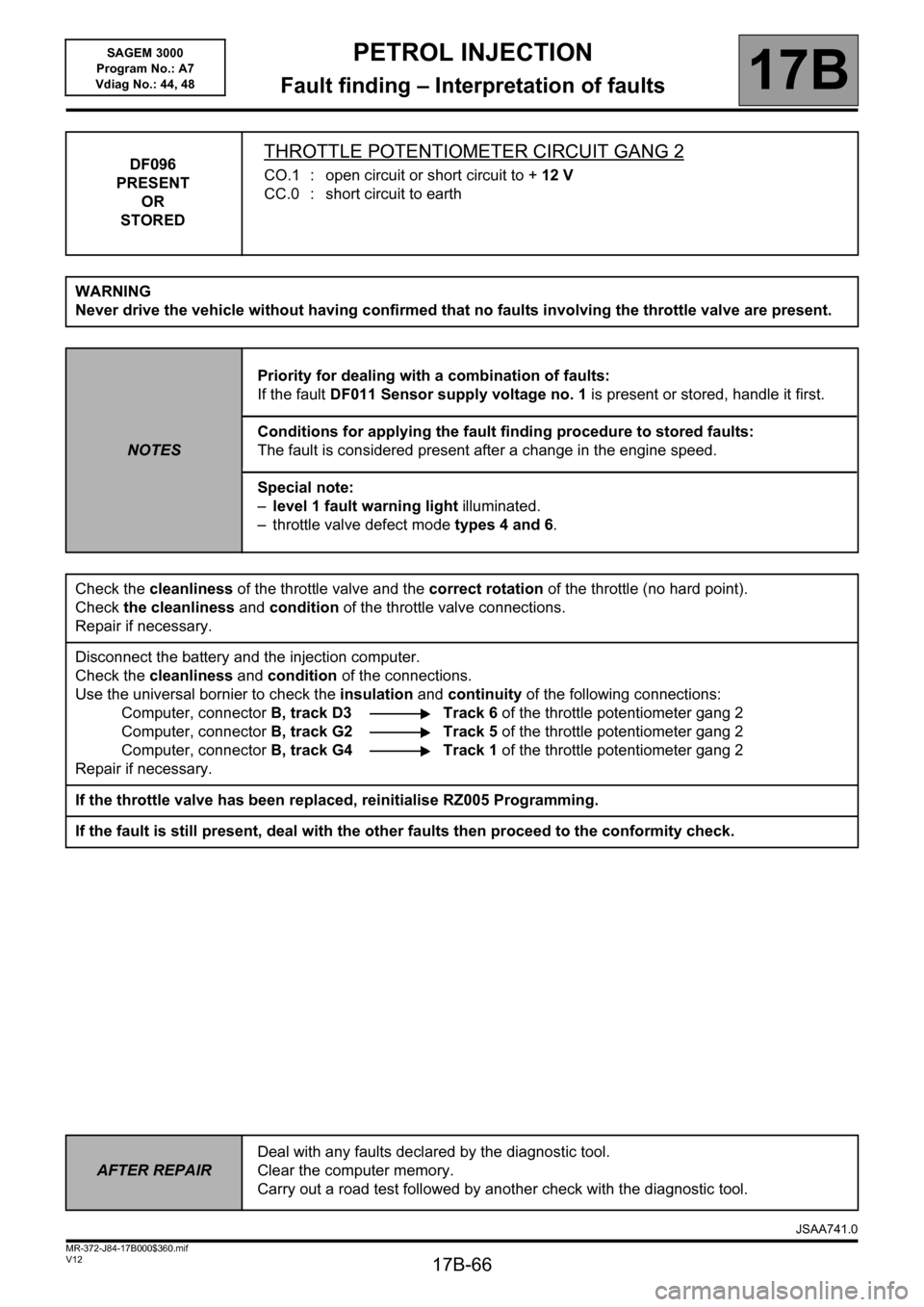
PETROL INJECTION
Fault finding – Interpretation of faults17B
17B-66V12 MR-372-J84-17B000$360.mif
SAGEM 3000
Program No.: A7
Vdiag No.: 44, 48
DF096
PRESENT
OR
STOREDTHROTTLE POTENTIOMETER CIRCUIT GANG 2
CO.1 : open circuit or short circuit to +12 V
CC.0 : short circuit to earth
WARNING
Never drive the vehicle without having confirmed that no faults involving the throttle valve are present.
NOTESPriority for dealing with a combination of faults:
If the fault DF011 Sensor supply voltage no. 1 is present or stored, handle it first.
Conditions for applying the fault finding procedure to stored faults:
The fault is considered present after a change in the engine speed.
Special note:
–level 1 fault warning light illuminated.
– throttle valve defect mode types 4 and 6.
Check the cleanliness of the throttle valve and the correct rotation of the throttle (no hard point).
Check the cleanliness and condition of the throttle valve connections.
Repair if necessary.
Disconnect the battery and the injection computer.
Check the cleanliness and condition of the connections.
Use the universal bornier to check the insulation and continuity of the following connections:
Computer, connector B, track D3 Track 6 of the throttle potentiometer gang 2
Computer, connectorB, track G2 Track 5 of the throttle potentiometer gang 2
Computer, connectorB, track G4 Track 1 of the throttle potentiometer gang 2
Repair if necessary.
If the throttle valve has been replaced, reinitialise RZ005 Programming.
If the fault is still present, deal with the other faults then proceed to the conformity check.
AFTER REPAIRDeal with any faults declared by the diagnostic tool.
Clear the computer memory.
Carry out a road test followed by another check with the diagnostic tool.
JSAA741.0
Page 73 of 181
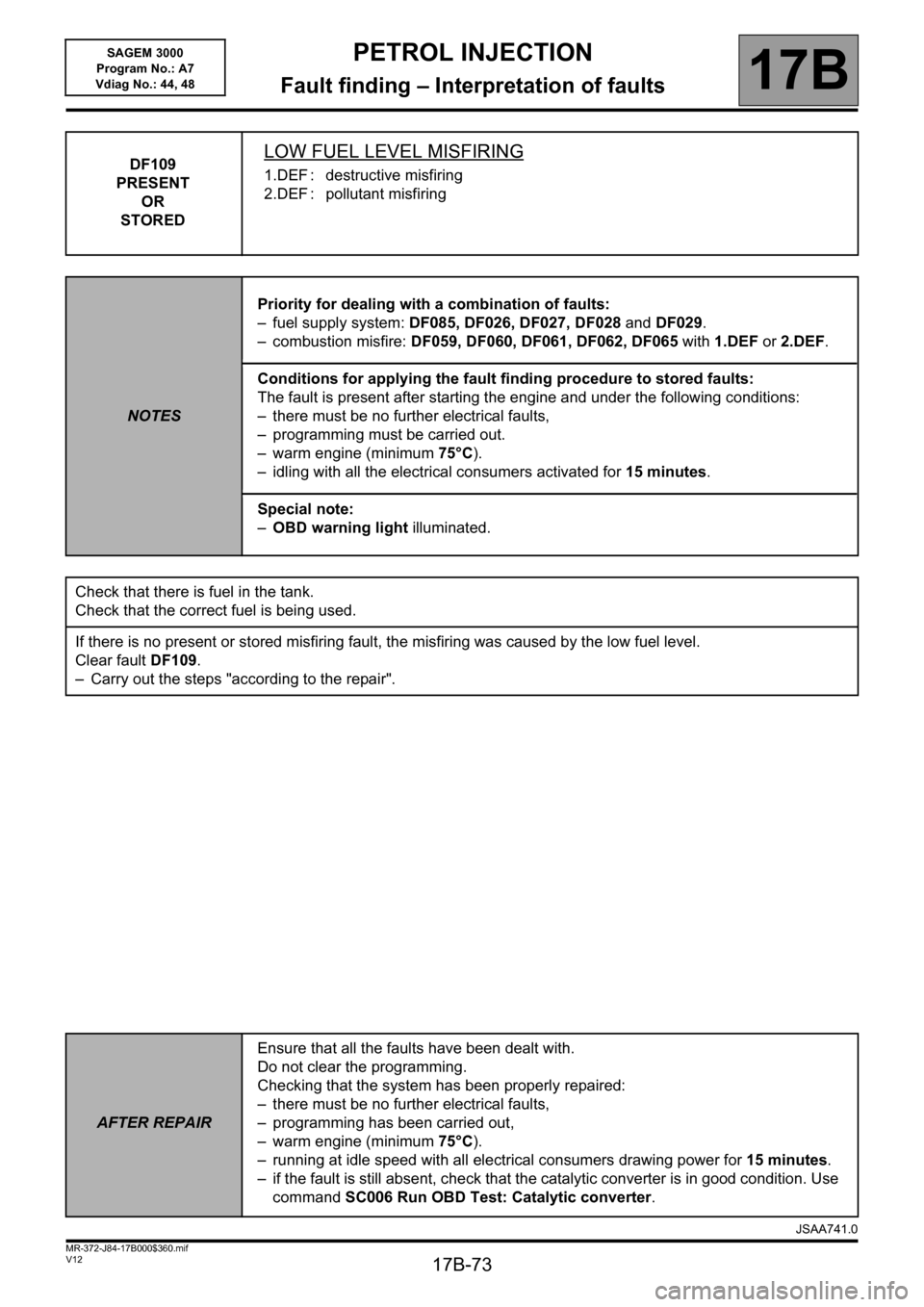
PETROL INJECTION
Fault finding – Interpretation of faults17B
17B-73V12 MR-372-J84-17B000$360.mif
SAGEM 3000
Program No.: A7
Vdiag No.: 44, 48
DF109
PRESENT
OR
STOREDLOW FUEL LEVEL MISFIRING
1.DEF : destructive misfiring
2.DEF : pollutant misfiring
NOTESPriority for dealing with a combination of faults:
– fuel supply system: DF085, DF026, DF027, DF028 and DF029.
– combustion misfire: DF059, DF060, DF061, DF062, DF065 with 1.DEF or 2.DEF.
Conditions for applying the fault finding procedure to stored faults:
The fault is present after starting the engine and under the following conditions:
– there must be no further electrical faults,
– programming must be carried out.
– warm engine (minimum 75°C).
– idling with all the electrical consumers activated for 15 minutes.
Special note:
–OBD warning light illuminated.
Check that there is fuel in the tank.
Check that the correct fuel is being used.
If there is no present or stored misfiring fault, the misfiring was caused by the low fuel level.
Clear fault DF109.
– Carry out the steps "according to the repair".
AFTER REPAIREnsure that all the faults have been dealt with.
Do not clear the programming.
Checking that the system has been properly repaired:
– there must be no further electrical faults,
– programming has been carried out,
– warm engine (minimum 75°C).
– running at idle speed with all electrical consumers drawing power for 15 minutes.
– if the fault is still absent, check that the catalytic converter is in good condition. Use
command SC006 Run OBD Test: Catalytic converter.
JSAA741.0